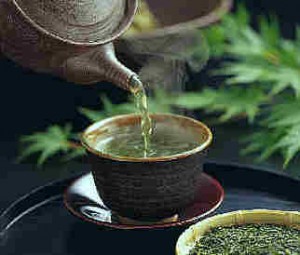In Japan, tea is drunk all day, from breakfast to dinner. If you go to any business meeting, you will be automatically served with a cup of tea. All hotels and accommodation in Japan are also equipped with tea-making equipment. In a restaurant, your tea cup will be constantly topped up. it is inconceivable to have a meal without tea. In other words, tea is drunk all the time, everywhere.
 Freshly picked tea leaves are immediately steamed to prevent discolouring and fermentation, then dried by rolling, crumbling and finally by hot air. The colour, aroma and shape of the leaves define the quality of the tea. Japanese green tea should not be brewed with boiling hot water, and the better the quality of tea, the lower the temperature of the water used. Below are listed five of the most common varieties of tea drunk with or without meals, but there are many more varieties of tea – some common to all Japan, and some local varieties or imported favourites.
Freshly picked tea leaves are immediately steamed to prevent discolouring and fermentation, then dried by rolling, crumbling and finally by hot air. The colour, aroma and shape of the leaves define the quality of the tea. Japanese green tea should not be brewed with boiling hot water, and the better the quality of tea, the lower the temperature of the water used. Below are listed five of the most common varieties of tea drunk with or without meals, but there are many more varieties of tea – some common to all Japan, and some local varieties or imported favourites.Gyokuro
Its name means ‘jewel dew’, and is the highest quality tea made from young tender leaves picked in early spring. The tea leaves are highly fragrant and a deep shiny green. This tea should be brewed in warm water, at about 50 degrees C, in small amounts, for no more than 2-3 minutes. It is drunk on its own or accompanied with wagashi (Japanese sweets), but not with meals.
Sencha
This literally means ‘infused tea’. It is a middle-ranking, good everyday tea drunk at home. This tea should be brewed is water at about 60 degrees C, and can be brewed a second time, but in slightly hotter water.
Bancha
This is an everyday, ordinary drinking tea freely served in restaurants and offices. It is made of larger leaves and stems and makes a yellowish green tea. There are varying qualities of bancha, and the lower the grade, the more stems and even twigs are included.
Genmaicha
This is a mixture of bancha and toasted rice grains which has a nutty aroma and mild flavour.
